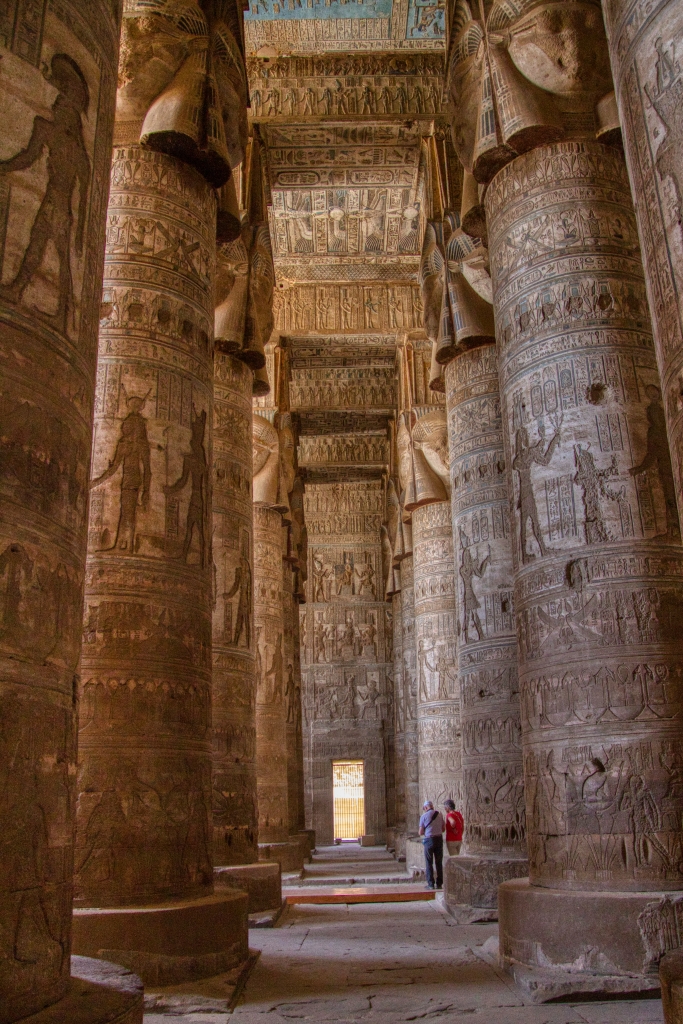
Photo by Galen C. Dalrymple, copyright 2024. All Rights Reserved.
I have a dilemma. I have so many photos from my trip to Egypt and many of them are similar to others. Yet, I am still drawn to them. When I look at them, I am reminded of the feeling and emotions I had as I wandered through the ancient temples, surrounded by magnificent columns adorned with carvings and artwork. And I would love to share them all with you. Here’s my fear: that you’ll get tired of them because to you, they’re just pictures, but to me, they’re a lived experience.
That’s perhaps one of the most amazing things about photography: they are snapshots (literally) of life experiences. The power to capture the feelings as well as the images, is a modern wonder that we take for granted.
Today’s photo was taken at the Temple of Hathor. The temple complex displays influences from Egyptian, Greek, and Roman rulers. There was also a Coptic Christian church on the premises near the birthing temple at one point. The main temple was built by Ptolemy XII and nearly completed by Queen Cleopatra VII (yes, THAT Cleopatra), around 54 to 20 BCE. There is evidence of temples and other structures that date back all the way to 2500 BCE.
Hathor is the Egyptian sky goddess of sexual love, fertility, music, and dancing. It is also said she is the goddess of birth and motherhood. She is often depicted as the counterpart of Horus. In fact, Hathor translates to “House of Horus.” Inside the underground crypt, on the same relief wall as the famed Dendera light bulb (just to the right of it) is the most detailed depiction of Horus discovered to date. Getting to the crypt requires you to crawl on your hands and knees for a stint. Well, maybe not crawl, but entrance requires going down a steep staircase, turning around, getting on your knees and backing through so you don’t hit your head. If you are short, it helps.
ON THIS DAY IN HISTORY: in 1961, President John F. Kennedy announces to Congress his goal of sending an American to the moon by the end of the decade and asks for financial support of an accelerated space program. He made the task a national priority and a mission in which all Americans would share, stating that it will not be one man going to the moon—it will be an entire nation.
On April 12, 1961, the Soviet Union had become the first country to send a man into space with the successful mission of Yuri Gagarin in the spacecraft Vostok 1. On May 5, American Alan Shepard flew into space, but did not orbit the earth as the Russian cosmonaut had. At that time, the U.S. and the Soviet Union were already locked in an arms race. Not to be outdone by America’s Cold War rivals, President Kennedy pledged in 1961 to support an American space program that would eventually dwarf the Soviet program in technological achievements and investment.
In a speech before Congress on May 25, JFK linked the need for a space program with the political and economic battle between democracy and communism. He urged Congress to mobilize financial resources to speed up the pace of the space program’s progress.
Kennedy’s vision did not become a reality until six years after his assassination. On July 20, 1969, then-President Richard Nixon watched with the world while Apollo 11 commander Neil Armstrong became the first human to walk on the moon. Just after Armstrong planted the American flag on the moon, President Nixon contacted Armstrong via phone to congratulate him on behalf of all Americans saying, “I just can’t tell you how proud we are.” – The History Channel
TRIVIA FOR TODAY: Humans shed about 600,000 particles of skin every hour. By age 70, humans lose an average of 105 pounds of skin.